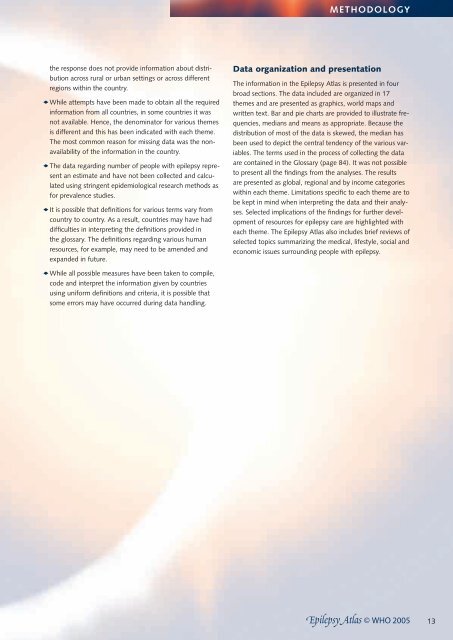Epilepsy - World Health Organization
Epilepsy - World Health Organization
Epilepsy - World Health Organization
Create successful ePaper yourself
Turn your PDF publications into a flip-book with our unique Google optimized e-Paper software.
the response does not provide information about distribution<br />
across rural or urban settings or across different<br />
regions within the country.<br />
◆ While attempts have been made to obtain all the required<br />
information from all countries, in some countries it was<br />
not available. Hence, the denominator for various themes<br />
is different and this has been indicated with each theme.<br />
The most common reason for missing data was the nonavailability<br />
of the information in the country.<br />
◆ The data regarding number of people with epilepsy represent<br />
an estimate and have not been collected and calculated<br />
using stringent epidemiological research methods as<br />
for prevalence studies.<br />
◆ It is possible that definitions for various terms vary from<br />
country to country. As a result, countries may have had<br />
difficulties in interpreting the definitions provided in<br />
the glossary. The definitions regarding various human<br />
resources, for example, may need to be amended and<br />
expanded in future.<br />
◆ While all possible measures have been taken to compile,<br />
code and interpret the information given by countries<br />
using uniform definitions and criteria, it is possible that<br />
some errors may have occurred during data handling.<br />
METHODOLOGY<br />
Data organization and presentation<br />
The information in the <strong>Epilepsy</strong> Atlas is presented in four<br />
broad sections. The data included are organized in 17<br />
themes and are presented as graphics, world maps and<br />
written text. Bar and pie charts are provided to illustrate frequencies,<br />
medians and means as appropriate. Because the<br />
distribution of most of the data is skewed, the median has<br />
been used to depict the central tendency of the various variables.<br />
The terms used in the process of collecting the data<br />
are contained in the Glossary (page 84). It was not possible<br />
to present all the findings from the analyses. The results<br />
are presented as global, regional and by income categories<br />
within each theme. Limitations specific to each theme are to<br />
be kept in mind when interpreting the data and their analyses.<br />
Selected implications of the findings for further development<br />
of resources for epilepsy care are highlighted with<br />
each theme. The <strong>Epilepsy</strong> Atlas also includes brief reviews of<br />
selected topics summarizing the medical, lifestyle, social and<br />
economic issues surrounding people with epilepsy.<br />
13

















